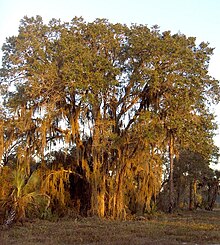| Sand live oak | |
|---|---|

| |
| Acorns and leaves of a sand live oak in Florida | |
| Conservation status | |
 Least Concern (IUCN 3.1) | |
| Scientific classification | |
| Kingdom: | Plantae |
| Clade: | Tracheophytes |
| Clade: | Angiosperms |
| Clade: | Eudicots |
| Clade: | Rosids |
| Order: | Fagales |
| Family: | Fagaceae |
| Genus: | Quercus |
| Subgenus: | Quercus subg. Quercus |
| Section: | Quercus sect. Virentes |
| Species: | Q. geminata |
| Binomial name | |
| Quercus geminata Small | |
| Synonyms | |
| List | |

Quercus geminata, commonly called sand live oak, is an evergreen oak tree native to the coastal regions of the subtropical southeastern United States, along the Atlantic Coast from southern Florida northward to southeastern Virginia and along the Gulf Coast westward to southern Mississippi, on seacoast dunes and on white sands in evergreen oak scrubs.
Taxonomy
Quercus geminata is placed in the southern live oaks section of the genus Quercus (section Virentes).
Appearance
A small- to medium-sized tree, the sand live oak is scrubby and forms thickets. The bark is dark, thick, furrowed, and roughly ridged. The leaves are thick, leathery, and coarsely veined, with extremely revolute margins, giving them the appearance of inverted shallow bowls; their tops dark green, their bottoms dull gray and very tightly tomentose, and their petioles densely pubescent, they are simple and typically flat with bony-opaque margins, having a length of 2–12 centimetres (3⁄4–4+3⁄4 inches) and a width of 0.5–4 cm (1⁄4–1+1⁄2 in). The male flowers are green hanging catkins. The acorns are small, 1–2.5 cm, oblong-ellipsoid or ovoid, and are commonly born in pairs on peduncles of varying lengths.
The Florida Native Plant Society describes the plant as "Extremely drought tolerant" and a long-lived perennial.
Description
In coastal Florida's evergreen oak scrub, the sand live oak is a ubiquitous and abundant species; the threatened Florida scrub-jay is found only in Florida scrub. Live oaks, having characteristics of the sand live oak and the southern live oak (Q. virginiana), grow further inland.
Hybrids
It is believed that these specimens are hybrids of Q. geminata and Q. virginiana. While hybridization occurs between Q. geminata and Q. virginiana, the two species are genetically and morphologically distinct. The Cuban oak, Q. sagrana, has been purported to be a hybrid between the sand live oak and Q. oleoides, but recent evidence suggests that the Cuban oak is a separate species without hybrid origin.
References
- Kenny, L.; Wenzell, K. (2015). "Quercus geminata". IUCN Red List of Threatened Species. 2015: e.T194134A2302219. doi:10.2305/IUCN.UK.2015-4.RLTS.T194134A2302219.en. Retrieved 19 November 2021.
- ^ Kurz, Herman; Godfrey, Robert K. (1962), Trees of Northern Florida, Gainesville, Florida, US: University Press of Florida, pp. 75–77, ISBN 978-0-8130-0666-6
- ^ Nelson, Gil (1994), The Trees of Florida: A Reference and Field Guide, Sarasota, Florida, US: Pineapple Press, p. 86,185,186,196, ISBN 978-1-56164-055-3
- "Quercus geminata Small", World Checklist of Selected Plant Families, Royal Botanic Gardens, Kew – via The Plant List Note that this website has been superseded by World Flora Online
- "FloriData — Quercus geminata", Retrieved 2011-07-06
- Denk, Thomas; Grimm, Guido W.; Manos, Paul S.; Deng, Min & Hipp, Andrew L. (2017). "Appendix 2.1: An updated infrageneric classification of the oaks" (xls). figshare. doi:10.6084/m9.figshare.5547622.v1. Retrieved 2023-02-18.
- "Florida Native Plant Society (FNPS)". www.fnps.org. Retrieved 2024-05-02.
- "Scrub", archived from the original on June 1, 2011, retrieved July 8, 2011 "The University of Florida – School of Forest Resources & Conservation — Scrub", Retrieved 2011-07-08
- "An Ecological Overview Of Scrub Habitat And Florida Scrub-Jays In Brevard County", Retrieved 2011-07-08
- Cavender-Bares, Jeannine; Pahlich, Anette (2009), "Molecular, morphological and ecological niche differentiation of sympatric sister oak species, Quercus virginiana and Q. geminata (Fagaceae)", American Journal of Botany, 96 (9): 1690–1702, doi:10.3732/ajb.0800315, PMID 21622355
- Nixon, Kevin C. (1997), "Quercus geminata", in Flora of North America Editorial Committee (ed.), Flora of North America North of Mexico (FNA), vol. 3, New York and Oxford: Oxford University Press, retrieved 2011-07-06 – via eFloras.org, Missouri Botanical Garden, St. Louis, MO & Harvard University Herbaria, Cambridge, MA
- Muller, Cornelius H. (1955), "The origin of Quercus on Cuba", Revista de la Sociedad Cubana de Botánica, 7: 41–47
- Gugger, Paul F.; Cavender-Bares, Jeannine (2012), "Molecular and morphological support for a Florida origin of the Cuban oak", Journal of Biogeography, 40 (4): 632–645, doi:10.1111/j.1365-2699.2011.02610.x
External links
- "Carolina Nature – Will Cook's Web Site" – close-up photographs
| Taxon identifiers | |
|---|---|
| Quercus geminata |
|